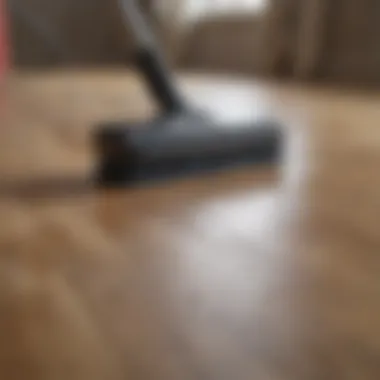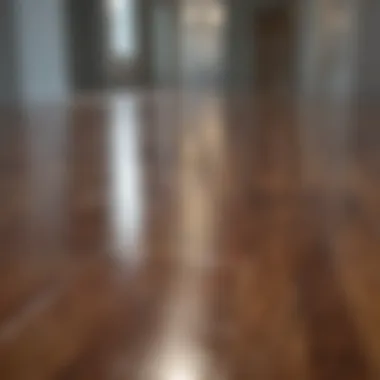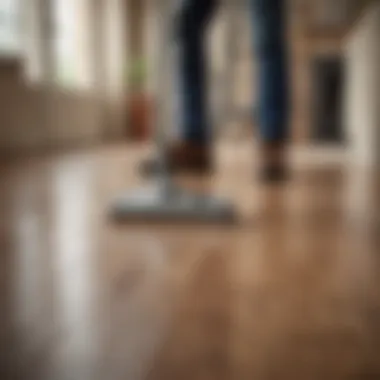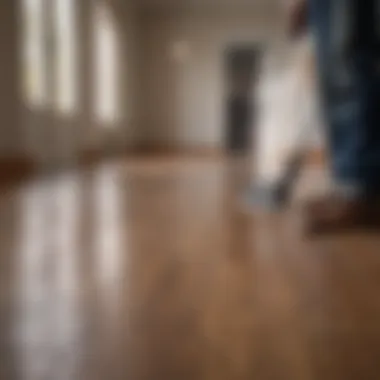Expert Tips for Cleaning and Polishing Laminate Floors


Intro
Maintaining laminate floors involves understanding their unique needs. Unlike hardwood, laminate flooring requires specific cleaning approaches to preserve its shine and durability. This guide aims to equip homeowners and enthusiasts with effective methods to clean and polish laminate floors effectively. From selecting the right tools to following detailed steps, each component is essential to achieving a pristine result. By focusing on these practices, one can enhance the aesthetic appeal and longevity of laminate surfaces in their homes.
Home Features
Architectural Styles
Laminate flooring is versatile. It complements diverse architectural styles, from traditional to contemporary designs. Its ability to mimic natural materials enhances various settings. Homes featuring open floor plans often leverage laminate for its functionality and aesthetic flexibility.
Interior Design Trends
Current interior design trends highlight the importance of sustainability and practicality. Laminate floors align well with this movement, offering eco-friendly options without sacrificing style. Popular trends include light-colored flooring, which creates an airy feel, and textured finishes that add depth and interest to interior spaces.
Essential Tools for Cleaning and Polishing
To maintain the beauty of laminate floors, specific tools are necessary. Key items include:
- Broom or Vacuum: Regular sweeping to remove dust and debris.
- Microfiber Mop: Prevents streaks while being gentle on surfaces.
- Laminate Floor Cleaner: Designed specifically for laminate to avoid damage.
- Polishing Solution: Used sparingly to restore shine.
Investing in these tools will enhance your cleaning routine, making it efficient and effective.
Step-by-Step Cleaning Guide
Preparation
Start by removing any furniture and obstacles from the flooring area. This allows for comprehensive cleaning and avoids missing spots.
Sweep or Vacuum
Using a soft-bristle broom or vacuum, remove loose dirt and debris. Pay attention to corners and edges where dirt can accumulate.
Mop the Floors
Dampen a microfiber mop with laminate floor cleaner. Ensure that the mop is not overly wet, as excess water can harm the surface. Clean in sections, working from one side of the room to the other.
Drying
After mopping, ensure the floor dries fully. This is essential to maintain the laminate's integrity and appearance.
Polishing Techniques
Selecting the Right Product
Choose a polishing solution that is safe for laminate floors. Products like Bona Laminate Floor Polish work well. Always test the product in a small area first to check for compatibility.
Applying Polish
Use a clean, dry microfiber mop to apply the polish in even strokes. Allow sufficient drying time according to the product instructions.
Maintenance Tips
To keep laminate floors in optimal condition, consider:
- Avoiding Excess Water: Never soak the surface.
- Using Area Rugs: Protect high-traffic areas.
- Regular Cleaning Schedule: Maintain a routine to prevent buildup.
Following these guidelines enhances the longevity and beauty of laminate floors, making them more inviting and stylish in any home setting.
End
In summary, cleaning and polishing laminate floors is a manageable task when approached methodically. By implementing the right tools and techniques, one can achieve excellent results. The effort put into maintaining these surfaces will reward homeowners with a visually appealing and durable floor that stands the test of time.
Understanding Laminate Floors


Understanding laminate floors is crucial for homeowners and interior design enthusiasts. This knowledge lays the foundation for effective maintenance, including cleaning and polishing techniques. Laminate flooring is widely appreciated for its aesthetic appeal and functionality. Many prefer it due to its versatility in various design settings.
Composition of Laminate Flooring
Laminate flooring is a multi-layer synthetic product fused together through a lamination process. The bottom layer usually consists of melamine resin, providing the floor with stability and moisture resistance. Above this base, there is a core layer made of high-density fiberboard, which adds strength and durability. The top layer, known as the decorative layer, showcases a printed image that mimics natural wood or stone.
This composition results in a floor that is both stylish and practical. Its resilience to wear and tear makes it a favored option among busy households. Understanding this structure helps in selecting the right cleaning products that won’t damage any component of the laminate.
Benefits of Laminate Floors
The advantages of laminate flooring are noteworthy for potential buyers and current owners. Firstly, its affordability compared to hardwood and stone makes it accessible for a wide range of budgets. Furthermore, the installation process is relatively simple, requiring fewer skills and tools.
Additionally, laminate floors are easy to maintain. Regular cleaning procedures require minimal effort due to the smooth surface that resists dust and dirt accumulation. A significant benefit is its durability; laminate can withstand significant foot traffic without significant wear. Investing in laminate means investing in long-term value, especially for those who take steps to care for their floors properly.
Common Misconceptions
Despite its popularity, there are common misconceptions about laminate flooring. One prevalent myth is that laminate floors cannot be refinished or repaired. While it is true that they lack the ability to be sanded and restained like hardwood, it is possible to replace individual planks if necessary. This is an important consideration for those looking for longevity in flooring.
Another misconception is regarding moisture. Many believe laminate floors cannot handle any exposure to water. In fact, while they should not be submerged in water, modern laminate products come with moisture-resistant properties that can handle spills if cleaned immediately.
Understanding these facts can significantly enhance one’s experience with laminate flooring. It leads to informed choices in purchase and maintenance, ensuring the floors maintain their beauty and integrity over time.
Preparation for Cleaning
Preparation is crucial when it comes to cleaning laminate floors. A well-prepared environment not only facilitates effective cleaning but also prevents potential damage to the laminate surface. The first step to achieving a clean finish is to gather all necessary tools and evaluate the floor's condition.
Gathering Necessary Tools
Microfiber Mop
The microfiber mop is essential for cleaning laminate floors. Its absorbent properties effectively capture dirt and dust without scratching the surface. The key characteristic of a microfiber mop is its fine fibers, which can penetrate small crevices, ensuring a thorough clean. This choice is popular since it requires minimal cleaning solution and can be easily washed and reused. A unique feature is its lightweight design, making it user-friendly. However, if not properly maintained, it can harbor bacteria, so regular washing is advised.
Vacuum Cleaner
A vacuum cleaner specifically designed for hard floors plays a vital role in laminate care. The primary advantage of using a vacuum is its ability to efficiently remove loose dirt, pet hair, and debris. Key characteristics will often include suction settings adjustable for different surfaces and attachments for corners. Choosing a vacuum saves time and enhances the cleaning process. Some disadvantages include the need for electric outlets and battery life considerations. Yet, when chosen carefully, it can greatly enhance the cleanliness of your laminate floors.
Broom and Dustpan
Using a broom and dustpan is one of the traditional methods for maintaining laminate floors. This tool is ideal for quick clean-ups and is very handy in areas where a vacuum may not reach effectively. The soft bristles of a broom will not scratch the laminate but can collect small particles efficiently. This is beneficial as it allows for immediate attention to visible dirt. One noticeable downside is that it may not capture all debris, meaning it's often used alongside other tools.
Cleaning Solution
Selecting the proper cleaning solution is paramount in cleaning laminate floors without causing harm. An appropriate cleaner is generally pH-balanced and free of harsh chemicals or wax. This ensures that while the floor is cleaned, no residue is left behind, which could lead to dullness or damage. These solutions are beneficial as they can enhance shine and maintain the floor's integrity. However, using the wrong type can cause streaks or buildup, so it is vital to read product labels carefully.
Assessing Floor Condition
Before cleaning begins, assessing the floor condition is important. Look for any signs of wear, scratches, or stains. Understanding these aspects can help in choosing the right cleaning approach and products. If the floor is heavily damaged, more careful restoration might be necessary instead of standard cleaning.
Removing Obstacles
Clearing the floor of furniture and other items is essential for effective cleaning. Doing this not only gives a clear path for your tools but also ensures that no dirt is missed from under the furniture. Taking the time to do this can lead to a more thorough and satisfying cleaning process.
Effective Cleaning Techniques
Cleaning techniques hold significant importance for maintaining the aesthetic value and structural integrity of laminate floors. Different methods cater to various cleaning needs and situations. Implementing effective cleaning techniques not only enhances the appearance of the floors but also prolongs their lifespan. Regular cleaning prevents grime accumulation, which can lead to scratches or dullness. Therefore, understanding the methods available is essential for any homeowner seeking to keep their laminate floors in optimal condition.
Dry Cleaning Methods
Regular Sweeping
Regular sweeping represents a foundational method of keeping laminate floors clean. This technique primarily focuses on the removal of loose dust and debris. Its simple nature makes it a practical solution for daily maintenance. For many users, this technique is a go-to choice because it requires minimal time and effort. The key characteristic of regular sweeping lies in its efficiency in picking up particles that could scratch surfaces if left unattended.
One unique feature of sweeping is the ability to use various types of brooms. Soft-bristled brooms are effective for picking up fine particles while avoiding damage to the laminate surface. However, some may find that relying solely on sweeping does not address stubborn dirt and stains, highlighting its limitation as a standalone method in a comprehensive cleaning strategy.


Vacuuming Tips
Vacuuming offers a more thorough solution than sweeping. It captures not only visible dirt but also allergens and particles hidden in the floor’s texture. A vacuum with a hard floor setting is ideal for laminate as it avoids using a beater bar that can cause scratches. The benefit of vacuuming is its speed and depth of cleaning, which many homeowners appreciate.
When using a vacuum, it's important to choose one with proper attachments to prevent damage. Regarding drawbacks, those with larger debris may find that vacuuming requires more attention, as clogs can occur easily if not monitored. Thus, maintaining an awareness of vacuuming techniques can enhance overall floor care.
Wet Cleaning Methods
Choosing the Right Cleaner
When selecting a cleaning solution for laminate floors, it is vital to consider the composition of the cleaner. Products that are specifically designed for laminate or those labeled as ‘safe for wood floors’ are typically beneficial. The key characteristic of these cleaners is their ability to break down dirt without excessive moisture—a critical consideration because laminate floors can be susceptible to warping.
One advantage of choosing an appropriate cleaner is that it often prevents long-term damage. However, users should remain cautious of cleaners with harsh chemicals. These may strip the protective finish of the laminate, leading to dullness over time. As such, careful selection plays a crucial role in maintaining floor quality.
Proper Mopping Techniques
Proper mopping techniques can maximize the benefits of wet cleaning methods. Using a damp mop rather than a soaking wet one is crucial to prevent excess water from seeping into seams. The key characteristic of efficient mopping lies in its balance between effectiveness in removing dirt and ensuring that the laminate does not become waterlogged.
Employing techniques like using a figure-eight motion can help cover the surface area effectively. However, users must keep in mind that a poorly maintained mop can spread dirt, making it counterproductive. Therefore, regular cleaning of the mop heads should be part of the process to maintain optimal cleanliness.
Spot Cleaning
Dealing with Stains
Spot cleaning directly addresses specific stains or areas that require immediate attention. The approach involves identifying the type of stain, whether it's food, liquid, or a combination. The key characteristic of spot cleaning is its targeted action, which allows homeowners to prevent stains from becoming permanent.
Utilizing the correct cleaning solution relevant to the stain type enhances effectiveness. For instance, using a mild soap solution for general spills is often effective. Conversely, stubborn stains may require special attention. However, a disadvantage is that neglecting spot cleaning can lead to more severe issues, as stains may set in and become harder to remove over time.
Preventing Damage
Preventing damage to laminate floors is equally important as any cleaning technique. This involves applying practical measures to avoid scratches, dents, and stains. The key characteristic of preventative measures includes protecting high-traffic areas with carpets and placing mats at entrances. Using furniture pads can significantly reduce the risk of damage as well.
The unique feature of preventing damage is its proactive nature; it serves to shield the floor from harm before issues arise. This avoidance technique is considerably more favorable than dealing with repairs later, which can be both time-consuming and costly. Ultimately, integrating preventative actions into the regular maintenance routine can yield long-term benefits for laminate floor preservation.
Polishing Laminate Floors
Polishing laminate floors is an essential aspect of maintaining their aesthetic appeal and longevity. This process can enhance the visual depth of the surface while also providing protective benefits. Regular polishing can help restore the shine that diminishes over time due to wear, foot traffic, and environmental factors. Moreover, polished laminate floors can contribute to a cleaner, more welcoming space, making them particularly appealing for homeowners and real estate enthusiasts.
Understanding the Need for Polishing
Understanding why polishing is necessary sheds light on the overall maintenance of laminate flooring. Over time, laminate floors can lose their luster due to scratches, scuff marks, and accumulated dirt. Polishing not only helps to hide these imperfections but also adds a layer of protection against future damage. Without periodic polishing, the floors may appear dull and less inviting, which can impact the overall ambiance of a home. Thus, incorporating a polishing routine can revitalize the floors and maintain their functional integrity.
Selecting a Polish Product
Choosing the right polish is vital for achieving the desired results when maintaining laminate floors.
Types of Polishes
There are several types of polishes available in the market. Each type brings unique benefits to laminate floors. Water-based polishes are a popular choice for their ease of application and quick drying time. They often contain fewer harsh chemicals and provide a medium level of shine. On the other hand, solvent-based polishes can offer a stronger finish but may require more careful application due to their chemical content. The choice between these two depends on the extent of wear on the floor and the level of shine desired.
A key characteristic of water-based polishes is their environment-friendly formulation, making them suitable for indoor use. However, solvent-based options often offer a longer-lasting finish, protecting the floors effectively against daily wear and tear.
Natural vs. Commercial Options
When selecting polish, one must consider natural versus commercial options. Natural polish products are often derived from plant-based ingredients, appealing to those preferring eco-friendly solutions. They are generally less toxic and can be safer for households with pets and children.
On the contrary, commercial products might contain synthetic compounds designed for deeper cleans and long-lasting finishes. A unique feature of commercial options is their ability to tackle more persistent stains and offer enhanced durability. However, they may also emit strong odors during application, which is a consideration for sensitive individuals.
Application Process
The application process of polish is crucial to ensure an even finish and optimal protection for laminate floors.
Preparing the Surface


Before applying any polish, proper surface preparation is essential. This entails cleaning the floor thoroughly to remove dust and debris. A clean surface allows the polish to adhere better and ensures a smoother finish. Any residues from previous cleaners must be eliminated to avoid uneven application. The key characteristic of surface preparation is its contribution to the longevity of the polish application. Without preparation, the polish may not perform as intended, resulting in a subpar finish.
Polishing Techniques
After preparing the surface, the actual polishing techniques come into play. Using a soft, microfiber cloth or mop is often recommended for application. The polish should be applied in small sections to maintain control and ensure complete coverage. This method allows for a uniform application without streaks. The unique feature of this technique is its user-friendliness, making it accessible even for individuals new to floor maintenance. Moreover, proper technique enhances the overall appearance and durability of the sheen applied.
"Proper care and routine maintenance can drastically improve the lifespan and appearance of laminate floors."
Maintaining Laminate Floors
Maintaining laminate floors holds significant value in prolonging their lifespan and preserving their aesthetic appeal. Regular maintenance not only enhances the visual quality of the flooring but also reduces the likelihood of damage. Dust and dirt can accumulate over time, leading to scratches and dullness. Given the investment made in these floors, it's prudent to implement a robust maintenance routine. The goal is to ensure that every aspect of the laminate floor remains in optimal condition, fostering a welcoming and attractive living environment.
Routine Cleaning Schedule
Creating a routine cleaning schedule is essential for the upkeep of laminate floors. Regular cleaning can prevent the buildup of debris and grime. A good approach is to sweep or vacuum the floors at least twice a week. This should be followed by a damp mopping using a suitable cleaning solution. It's important to check the cleaner's label to ensure it is safe for laminate. Keeping this schedule can help in maintaining shine and avoiding stubborn stains.
Seasonal Deep Cleaning
In addition to routine cleaning, seasonal deep cleaning is important. This process allows for a thorough assessment of the floor's condition and helps remove deeper dirt or stains that may not be visible. Using a specialized laminate floor cleaner during this deep cleaning can make a difference in restoring the floor's original luster. Depending on foot traffic and general use, this deep cleaning should occur at least once every three to six months to ensure long-term maintenance.
Preventative Measures
Taking preventative measures can significantly enhance the durability of laminate floors. By being proactive, homeowners can avoid common pitfalls that lead to wear and tear. Below are some effective strategies.
Use of Area Rugs
Area rugs serve a significant role in protecting laminate floors. They act as barriers against dirt and moisture, which can damage the flooring over time. The key characteristic of area rugs is that they can absorb dirt and prevent scratches from furniture or heavy foot traffic. This makes them a popular choice among homeowners who want to maintain a clean appearance and protect their surfaces. The unique feature of area rugs lies in their versatility; they can complement various styles of decor while providing functionality. However, it is essential to ensure that the rugs have a non-slip backing to prevent accidents.
Furniture Pads
Furniture pads are a simple yet effective solution to prevent scratches on laminate floors. These pads are designed to cushion the impact of furniture legs, reducing the risk of scuff marks and dents. Their key characteristic is their ease of application; they can be placed under furniture without any tools or adhesive. This makes them a widely accepted choice for homeowners focused on maintaining their flooring. One unique feature is that furniture pads can come in various materials, including felt and rubber, offering different levels of protection. While they are generally beneficial, it is important to periodically check and replace them as they wear down, ensuring continued protection for laminate floors.
Troubleshooting Common Issues
Addressing common issues is crucial for maintaining the longevity and appeal of laminate floors. Understanding these challenges helps homeowners act decisively, preventing small problems from evolving into larger ones. This section explores common laminate floor issues and offers practical solutions.
Dealing with Scratches and Scuff Marks
Scratches and scuff marks can mar the visual appeal of laminate flooring. These imperfections are typically caused by everyday activities, such as moving furniture or footwear scraping against the floor. To effectively manage these issues, consider the following methods:
- Use a Scratch Remover: Products designed specifically for laminate scratches can be effective. They often come in various colors to match your floor's finish.
- Apply a Repair Kit: Many brands sell repair kits that include markers or crayons that blend into the floor's finish. Follow the instructions carefully for optimal results.
- Preventive Measures: Regularly using furniture pads can minimize the risk of scratches. Encourage family members to wear appropriate footwear indoors to reduce unwanted marks.
Addressing Water Damage
Water damage is a significant concern for laminate flooring, as excessive moisture can lead to warping or swelling. Immediate action is essential to prevent further harm. Here are steps to take when addressing water damage:
- Assess the Extent of Damage: Determine whether the damage is surface-level or has penetrated deeper into the layers of laminate.
- Dry the Affected Area: Quickly remove any standing water using a soft, absorbent cloth. For larger spills, use a wet vacuum if available.
- Allow Surface to Air Dry: Good air circulation can help reduce moisture levels. Open windows or use fans to expedite the drying process.
- Consider Replacement: If warping is severe, individual planks may need replacing. This will restore both function and aesthetics to your floor.
Fading and Dullness
Over time, laminate floors can fade or become dull due to sunlight exposure and wear. To combat this effect, consider the following steps:
- Use Window Treatments: Install blinds or curtains to reduce direct sunlight on the floor, thereby minimizing fading over time.
- Regular Cleaning: Dust and debris can dull the shine of your laminate floor. Establish a cleaning routine that involves sweeping or vacuuming and damp mopping.
- Apply a Polish: Occasionally applying a laminate floor polish can help rejuvenate its appearance. Ensure the product is compatible with your floor type.
Remember, proactive maintenance is essential to keep your laminate flooring looking vibrant and new. Regular assessments can help catch issues before they escalate, ensuring a long-lasting and visually appealing surface.
End
The conclusion of this article emphasizes the essential practices for maintaining laminate floors. Following a structured cleaning and polishing routine significantly enhances the longevity and aesthetics of these surfaces. Given the unique composition and common misconceptions surrounding laminate flooring, it is crucial to understand the specific care it requires. By adhering to the guidance provided, homeowners can safeguard their investments and continue to enjoy the beauty of their laminate floors. The benefits of maintaining these floors extend beyond mere appearances; they include the preservation of property value and the creation of a healthier living environment.
Summary of Key Points
- Laminate floors require regular cleaning with appropriate techniques to prevent damage.
- Selecting the right products, especially polish, can have a lasting impact on the appearance of the floors.
- Seasonal and preventive maintenance is essential in protecting laminate flooring from wear and tear.
- Troubleshooting common issues such as scratches and dullness can help homeowners maintain the integrity of the surface.
Final Thoughts on Maintenance
Proper maintenance of laminate floors is not just about aesthetics; it is an investment in the home’s future. Homeowners should develop a routine cleaning schedule that incorporates both dry and wet cleaning methods. Regular assessments of floor condition will help to identify issues before they escalate into larger problems.
Using area rugs and furniture pads can prevent scratches and protect the laminate surface. Ultimately, homeowners who invest time in maintaining their floors will reap rewards in terms of prolonged durability, beauty, and comfort. By following the principles outlined in this guide, anyone can achieve stunning laminate floors that add value and appeal to their living spaces.















